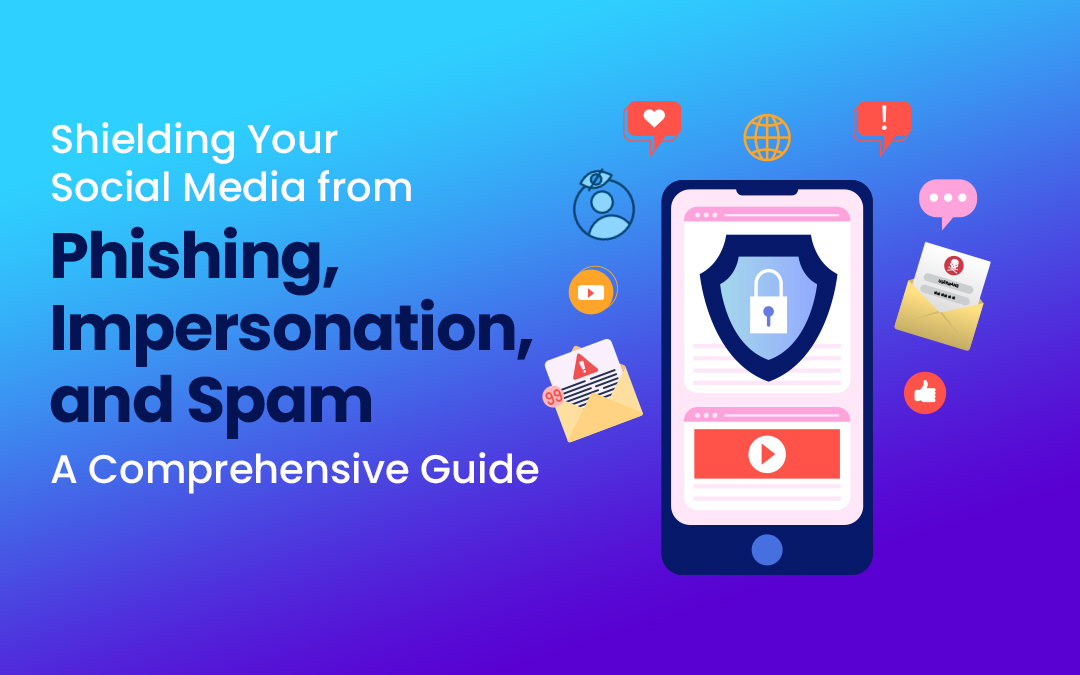
Social media is a powerful tool for businesses and individuals alike. It allows you to connect with customers, grow your brand, and engage with your audience on a global scale. However, this digital landscape also exposes you to several risks, including phishing attacks, impersonation, and spam. These threats can damage your reputation, compromise sensitive information, and erode the trust of your followers.
To keep your social media presence secure, it's essential to understand these risks and take the necessary steps to protect your accounts. In this comprehensive guide, we’ll discuss how phishing, impersonation, and spam can affect your social media presence, and provide actionable tips to shield yourself from these threats.
Understanding Phishing on Social Media
Phishing is one of the most common forms of cyberattacks on social media. In a phishing attack, hackers attempt to trick users into providing personal information, such as passwords, financial details, or other sensitive data, by pretending to be a legitimate source. These attacks can take the form of fake messages, emails, or even links that lead to fraudulent websites.
On social media, phishing often occurs when attackers create fake profiles that resemble legitimate brands or individuals. These fake accounts can send direct messages, comments, or posts designed to steal information from unsuspecting users.
The Dangers of Phishing on Social Media
Phishing attacks on social media can have far-reaching consequences. Once attackers gain access to your personal information or social media accounts, they can:
- Steal your identity and use it for fraudulent activities.
- Gain access to your business's confidential information.
- Target your followers with phishing schemes, damaging your reputation.
- Lock you out of your social media accounts, making it difficult to regain control.
Given the ease with which phishing attacks can occur, phishing protection should be a top priority for anyone managing a social media presence.

How to Protect Your Social Media from Phishing
Here are some strategies to help you protect yourself from phishing attacks on social media:
- Be Wary of Suspicious Messages and Links
Always be cautious when clicking on links sent via direct messages, especially if they come from unfamiliar or suspicious accounts. Attackers often send messages that appear to be from legitimate brands or friends, but the links direct you to phishing websites designed to steal your login credentials. If you receive a suspicious message, verify its authenticity by contacting the person or brand through a separate, trusted communication channel. Avoid clicking on unsolicited links or sharing personal information without confirming the legitimacy of the request. - Enable Two-Factor Authentication (2FA)
Two-factor authentication (2FA) adds an extra layer of security to your social media accounts. Even if a hacker obtains your password, they would still need access to your second form of verification, such as a text message or authentication app. By enabling 2FA, you significantly reduce the chances of someone successfully phishing your account. Most social media platforms offer 2FA as a security option, so be sure to activate it on all of your accounts. - Regularly Update Your Passwords
Changing your passwords frequently is a simple yet effective way to safeguard your accounts against phishing. Use complex passwords that combine letters, numbers, and special characters, and avoid using the same password across multiple accounts. Additionally, consider using a password manager to store and generate secure passwords.
Impersonation: A Growing Threat on Social Media
Impersonation occurs when someone creates a fake social media profile that closely mimics your brand or personal identity. These fake accounts are designed to deceive your followers, often tricking them into sharing personal information or purchasing fraudulent products. Impersonation can cause significant damage to your reputation and undermine the trust you’ve worked hard to build with your audience.
The Risks of Impersonation
When an impersonator uses your name, logo, or branding, it can have several negative effects on your business or personal brand, including:
- Loss of customer trust: If followers interact with an impersonator thinking they’re dealing with your brand, they may lose trust in you once they realize they’ve been misled.
- Damage to your reputation: Impersonators can post harmful content or engage in unethical behavior under your brand’s name, which can tarnish your image.
- Financial loss: Impersonators may trick customers into buying counterfeit products or sending payments to fraudulent accounts.
How to Prevent Impersonation on Social Media
Here are some steps you can take to protect yourself from impersonation on social media:
- Secure Your Social Media Handles
To reduce the risk of impersonation, claim your brand’s social media handles on all major platforms, even if you don’t plan on using them right away. This prevents impostors from using your name and confusing your followers. Keep your profile handles consistent across platforms to make it easy for users to identify your legitimate accounts. Additionally, seek verification badges (such as the blue checkmark) from platforms like Instagram, Twitter, and Facebook. These badges indicate that your account is authentic and give your audience confidence that they are interacting with the real you. - Monitor for Fake Accounts
Regularly search for any variations of your brand’s name or personal identity across social media platforms. Impersonators often create fake accounts that look similar to legitimate ones, using slight changes in spelling or additional characters. If you discover a fake account, report it immediately to the platform to have it removed. You can also set up alerts with social media monitoring tools to notify you when someone mentions your brand or uses a similar handle. - Educate Your Audience
Inform your followers about the possibility of impersonation and provide guidance on how they can identify your official accounts. Let them know what to look for, such as the verification badge or specific details that distinguish your profile from impostors. Encourage them to report any suspicious activity or fake accounts they encounter.
The Impact of Spam on Social Media
Spam is another major issue that plagues social media platforms. Spam typically takes the form of irrelevant or unsolicited messages, comments, or posts that flood your social media pages. This can range from excessive promotions to irrelevant links and fake accounts posting disruptive content. While spam may seem like a minor inconvenience, it can have serious consequences for your social media success.
The Consequences of Spam
Decreased engagement: Spam discourages genuine followers from interacting with your content, reducing the overall engagement on your posts.
Harm to your reputation: A spam-filled comment section can make your brand look unprofessional or poorly managed, causing potential customers to lose trust.
Reduced content visibility: Many social media platforms use algorithms to determine the visibility of posts. A high volume of spam can lower your content’s quality rating, leading to reduced reach.
How to Combat Spam on Social Media
To minimize spam on your social media pages, follow these key strategies:
- Use Comment Filters
Most social media platforms allow you to set up comment filters that block certain words or phrases associated with spam. By enabling these filters, you can automatically prevent spammy comments from appearing on your posts. - Report and Block Spam Accounts
If you encounter a spam account, block and report it to the platform. This helps prevent the account from continuing to post spam on your page and contributes to overall platform security. - Leverage Third-Party Tools
Several third-party tools, such as Hootsuite and Sprout Social, provide advanced spam filtering and moderation features. These tools can help you monitor comments, flag suspicious content, and maintain a cleaner social media presence.
Staying Proactive to Protect Your Social Media Presence
Phishing, impersonation, and spam are serious threats to the safety and success of your social media presence. By implementing phishing protection measures, actively monitoring for fake accounts, and using tools to combat spam, you can safeguard your brand and maintain a secure, trustworthy online environment for your followers. Staying vigilant and proactive is the key to keeping these risks at bay and ensuring your social media platforms continue to serve as powerful tools for growth and engagement.
Share this post
Leave a comment
All comments are moderated. Spammy and bot submitted comments are deleted. Please submit the comments that are helpful to others, and we'll approve your comments. A comment that includes outbound link will only be approved if the content is relevant to the topic, and has some value to our readers.

Comments (0)
No comment